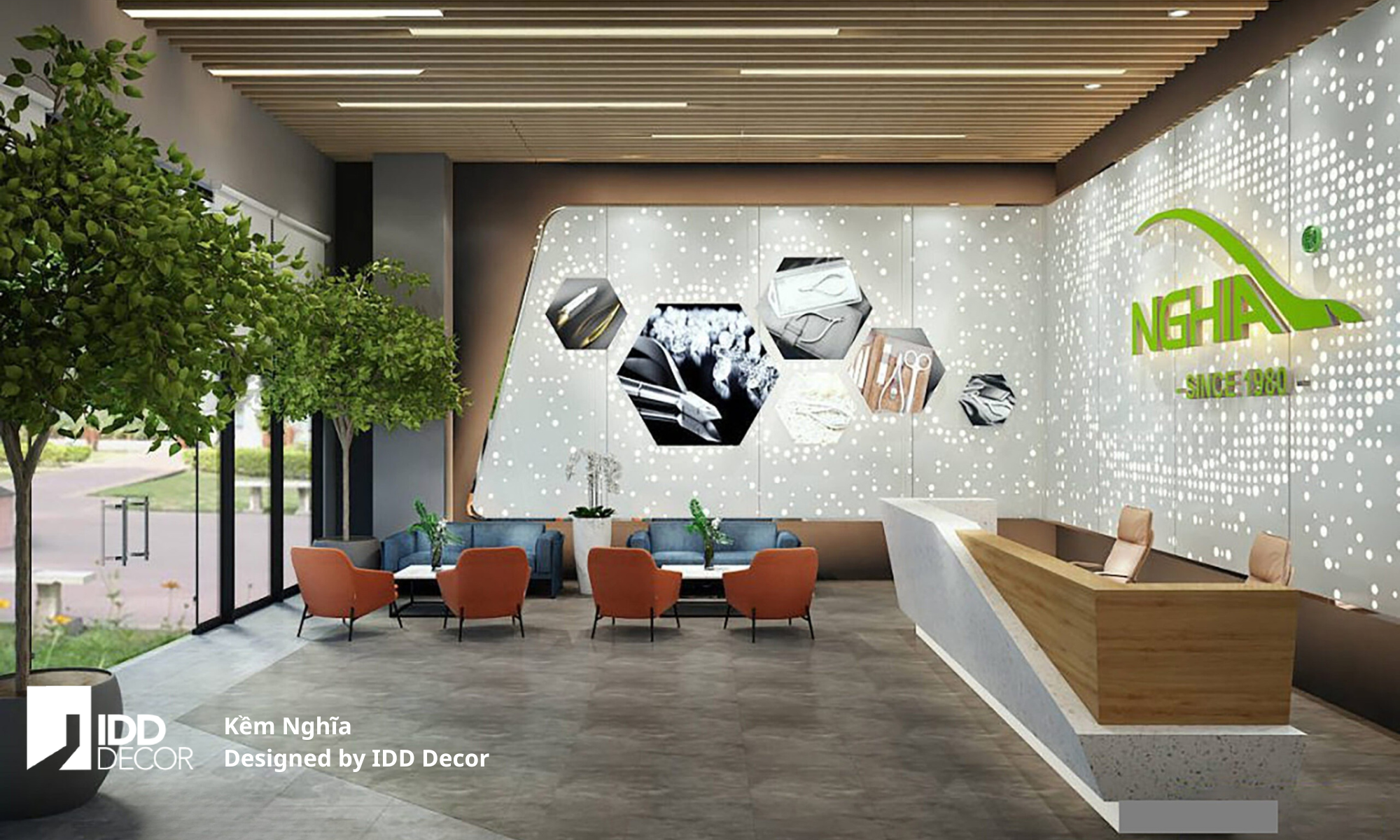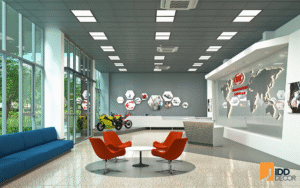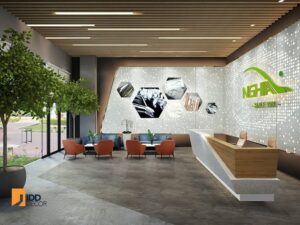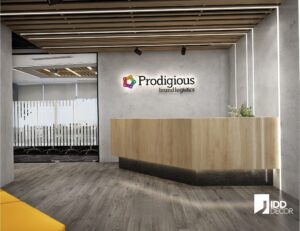
In today’s modern workplaces—especially for international corporations based in Vietnam—the reception area is more than just a functional space for welcoming guests. It serves as the brand’s first impression, reflecting professionalism, identity, and class.
Among all the design elements shaping this experience, lighting plays a uniquely strategic role — acting both as an aesthetic instrument and as a subtle expression of brand values. This article explores the importance of lighting in office reception design, outlines international standards, real-world examples, and explains why lighting should be considered a serious strategic investment.
The reception area defines the very first impression a visitor forms upon entering a corporate space. According to the Lighting Research Center – Rensselaer Polytechnic Institute, lighting has a profound impact on human emotions, behavior, and perception within interior environments (Source: LRC RPI). Therefore, lighting is not merely a utility—it is an essential part of a company’s branding strategy.
A well-designed lighting system enhances comfort, professionalism, and visual harmony, while poor lighting—whether too harsh or too dim—can undermine even the most carefully designed interiors, leaving a negative impression on clients or partners.
Reception lighting should highlight key brand elements such as the logo, nameplate, or signature materials used in the company’s design language. Depending on the business sector, different lighting styles convey distinct brand personalities:
Technology firms: Neutral white light with high intensity to suggest innovation and precision.
Financial and legal organizations: Warm, golden lighting to evoke trust, stability, and prestige.
Creative agencies: Playful combinations of colored and accent lighting to express creativity and energy.
According to Forbes (2018), first impressions are formed within just seven seconds of entering a space. Lighting immediately influences how visitors feel in those critical moments. A balanced and thoughtful lighting scheme can make guests feel welcome and confident in the company’s professionalism—fostering emotional connection and long-term engagement.
Lighting for reception areas is typically divided into four functional layers, each contributing to the overall effect:
Ambient Lighting – Provides general illumination for visibility and safety. Common solutions include recessed LED lights, cove lighting, and perimeter LED strips.
Accent Lighting – Used to emphasize focal points such as company logos, stone feature walls, or brand materials. Spotlight LEDs and wall washers are common.
Task Lighting – Supports specific activities like writing, data entry, and client interaction. This lighting is more focused and intense, often provided by desk lamps or localized overhead fixtures.
Decorative Lighting – Adds aesthetic value and conveys brand personality through artistic fixtures like chandeliers, pendant lights, or custom-designed luminaires.
According to the Illuminating Engineering Society (IESNA), reception areas should maintain 300–500 lux of illumination to meet both aesthetic and ergonomic standards (IES Lighting Handbook, 10th Edition).
The World Green Building Council reports that workspaces with access to natural daylight can increase productivity by up to 18% compared to those relying solely on artificial light (Source: WorldGBC).
Designers should therefore integrate natural light through glass facades, skylights, or clerestory windows—balanced with solar films or mesh curtains to prevent glare and thermal discomfort.
Lighting temperature should align with the brand’s industry and desired atmosphere:
2700–3000K: Warm tones—ideal for hospitality, education, or healthcare.
3500–4000K: Neutral white—suited for law, finance, and real estate.
5000K+: Cool tones—preferred by tech firms, engineering companies, and startups for a clean, high-performance vibe.
Using a layered lighting approach—combining ambient, accent, and indirect light—creates visual depth and dynamism. Spotlighting the logo, backlighting walls, and using floor uplights can visually expand compact or low-ceilinged spaces while adding sophistication.
 |
VPIC Group – Automotive Component ManufacturerIn the VPIC reception area, IDD Decor used spotlights to emphasize the logo on a stone feature wall. A combination of warm ceiling lighting and natural wood tones produced a sense of solidity and confidence—perfect for the industrial sector. |
|
Kềm Nghĩa – Global Vietnamese Brand For Kềm Nghĩa’s corporate office, IDD Decor implemented a neutral white lighting system that highlights marble and glass materials. The result is a refined, pure aesthetic that conveys both modernity and trustworthiness while ensuring optimal brightness for staff operations. |

|
|
|
|

|
CMA CGM – Global Logistics GroupAt CMA CGM’s Vietnam headquarters, multiple layers of lighting—recessed ceiling lights, logo spotlights, and wall uplights—create an open, international atmosphere. The mix of neutral and accent light enhances the brand’s global identity and sense of motion. |
|
|
|
Prodigious – Global Creative Agency (Publicis Groupe)For Prodigious Vietnam, IDD Decor turned lighting into part of the brand storytelling concept. The design avoided over-decoration, opting instead for refined, minimal, and meaningful illumination—reflecting the agency’s creative yet disciplined ethos. |
 |
Common issues include over-bright lighting causing glare, insufficient illumination at reception desks, or mismatched light colors with brand tones. These seemingly small flaws can significantly impact perception and employee comfort.
Sustainable lighting design is a growing priority under ESG frameworks and LEED certifications. Energy-efficient LEDs, daylight sensors, and automated controls not only reduce power consumption but also contribute to higher sustainability scores and brand reputation.
(Source: U.S. Green Building Council)
Reception lighting is more than a functional necessity—it’s an investment in brand experience. Thoughtful lighting design amplifies the brand’s identity, creates emotional resonance, and strengthens corporate image from the very first interaction.
In Vietnam’s competitive and globally integrated business environment, success often lies in the smallest details — and light is one of those silent forces that make a powerful impact.
IDD Decor – Office Interior Design – Behind every door lies the path to success.
📍 Address: Doxaco Building, 307B Nguyen Van Troi, Tan Son Hoa Ward (formerly Ward 1, Tan Binh District), Ho Chi Minh City, Vietnam
📞 Hotline: +84 896 640 986
🌐 Website: idddecor.com
🔗 LinkedIn: IDD Decor Vietnam